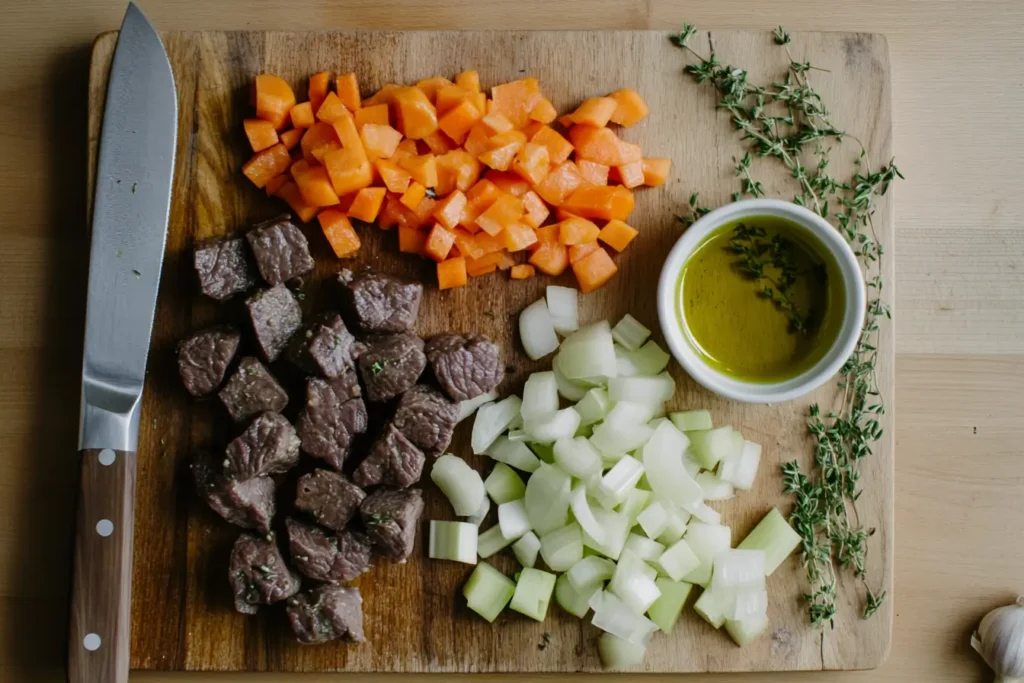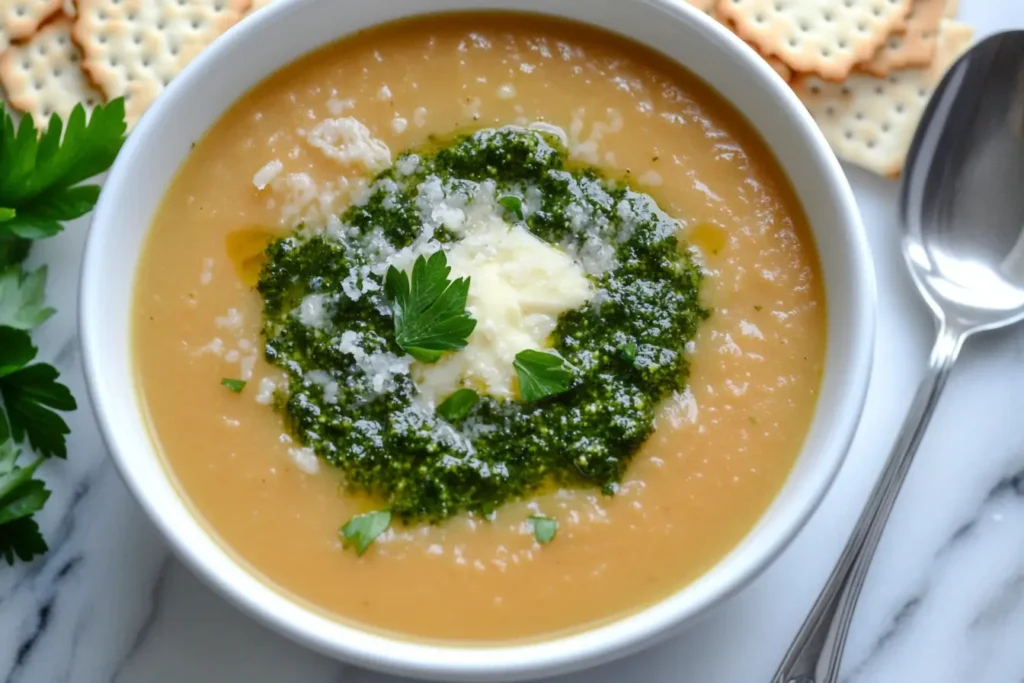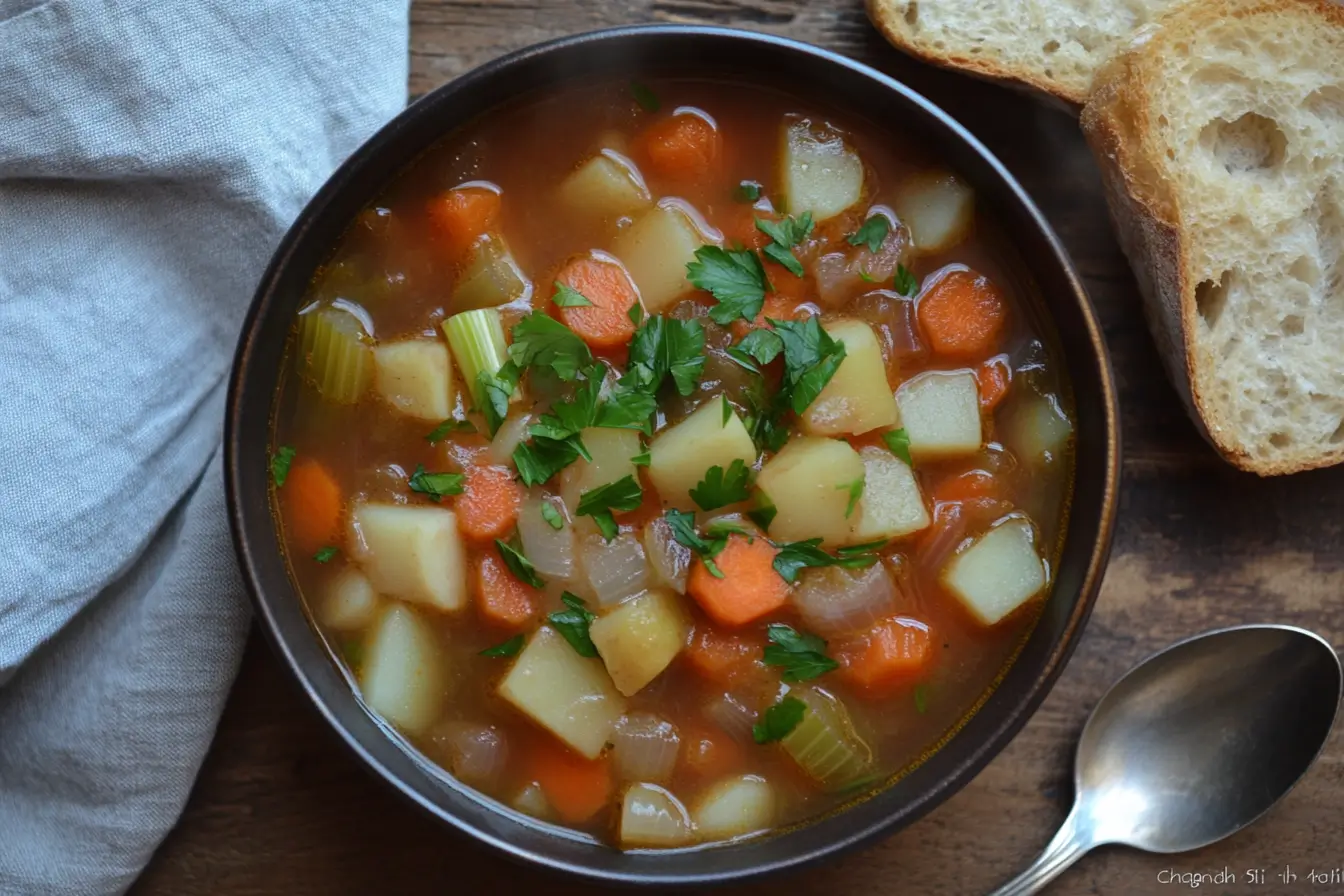Soup is a beloved dish worldwide, but what gives soup the best flavor? Is it the fresh ingredients, the seasoning, or the cooking technique? The truth is, crafting a soup that stands out requires understanding what gives soup the best flavor and using the right steps to enhance every element.
For many, the journey of discovering what gives soup the best flavor begins with choosing quality ingredients. From fresh vegetables to umami-rich additions like Parmesan rind or miso paste, these choices make a difference. The key is knowing how to build depth and balance, ensuring each bite is packed with rich, savory goodness.
Even if you’ve wondered, “What gives soup the best flavor when using store-bought stock?” the answer lies in layering flavors and seasoning at the right time. By following these techniques, you can turn an ordinary pot of soup into a flavorful masterpiece.
What Gives Soup the Best Flavor? Understanding the Basics
To understand what gives soup the best flavor, it’s important to consider how different elements contribute to the dish. A flavorful soup doesn’t happen by accident—it’s the result of intentional choices and methods. Homemade soups often taste better than store-bought options because they allow you to control every ingredient, ensuring the freshest and most natural flavors.
Flavor in soup comes from layering. This means starting with a strong base, such as a well-seasoned broth, and building on it with ingredients like vegetables, herbs, and spices. The slow simmering process allows these elements to blend together, creating a harmonious taste. If you’re looking to make your soups richer and more satisfying, focusing on these basics is the first step.
One of the most important aspects of making soup taste better is choosing fresh, high-quality ingredients. Without these, even the best techniques won’t achieve the results you want.
If you’re looking to add depth to your soup, check out these tips for enhancing homemade vegetable soup flavor.
How Fresh Ingredients Answer What Gives Soup the Best Flavor
The cornerstone of any delicious soup is the ingredients you use. If you’re wondering what gives soup the best flavor, start by selecting the freshest produce and the highest-quality stock available.
Fresh Vegetables Are Key
Vegetables are the heart of most soups, especially when making a classic vegetable soup. Start with carrots, celery, and onions—often referred to as mirepoix. This combination creates a flavorful foundation. Adding sweet potatoes or parsnips can introduce natural sweetness, while tomatoes contribute acidity and depth. Don’t forget to include a mix of leafy greens like spinach or kale for texture and nutrition.
Choose the Right Stock
Stock or broth forms the liquid base of your soup, and its quality directly impacts the flavor. Homemade stocks are ideal because they allow you to customize the taste, but store-bought options can also work if you choose carefully. Look for low-sodium versions so you can control the saltiness. Vegetable stock is great for lighter soups, while chicken or beef stock adds richness.
Herbs and Spices
Using a variety of herbs and spices is essential for enhancing soup taste. Fresh herbs like parsley, thyme, and rosemary add brightness, while dried spices such as paprika, turmeric, and cumin provide warmth and complexity. For a unique twist, simmer a Parmesan rind in your soup—it adds a savory, umami-rich flavor that makes the dish irresistible.
Ingredients like soy sauce, miso, mushrooms, or even a simple ham bone for vegetable soup can add incredible richness.
Aromatics and Seasonings: Key to What Gives Soup the Best Flavor

Aromatics are the unsung heroes of great soups. They’re the ingredients that infuse your soup with a deep, savory aroma, making every spoonful more enticing.
Aromatics typically include onions, garlic, leeks, celery, and sometimes ginger or shallots. To maximize their flavor, start by sautéing them in olive oil or butter before adding other ingredients. This step caramelizes the natural sugars in the vegetables, creating a rich base that sets the tone for the entire dish.
For example, garlic adds a pungent kick, while onions provide sweetness and depth. Celery contributes a subtle, earthy note that ties everything together. When cooked properly, these ingredients ensure your soup isn’t just good—it’s unforgettable.
For a unique touch, consider adding ingredients like bay leaves or a Parmesan rind to your broth. Learn more about the most important ingredients in soup.
How Sautéing Aromatics Enhances Soup Flavor
Creating a soup that tastes as good as it smells requires a thoughtful approach to layering flavors. Each ingredient you add should complement the others, gradually building complexity.
Cooking in Stages
Rather than throwing everything into the pot at once, add ingredients in stages. Start with aromatics, then introduce heartier vegetables like carrots and potatoes. This method ensures that each ingredient retains its texture and flavor, contributing to the overall dish.
Roasting Vegetables for Added Flavor

Roasting vegetables before adding them to your soup is another way to enhance its taste. It brings out the natural sweetness of ingredients like tomatoes, bell peppers, and squash. To roast, spread the vegetables on a baking sheet, drizzle with olive oil, and bake at 400°F until they’re slightly charred. Adding these to your soup creates a deeper, more robust flavor.
Deglazing the Pot
After sautéing your aromatics, deglaze the pot with a splash of wine, vinegar, or broth. This process lifts browned bits from the bottom of the pot, infusing your soup with rich, savory notes.
Learn why chefs add vinegar to soups and how this simple trick can transform your dishes.
What to Add to Soup to Enhance Flavor? Must-Have Ingredients
If you’ve ever wondered why some soups taste so rich and satisfying, the answer often lies in umami. Umami is a savory taste that adds depth and makes flavors more complex.
How Umami-Rich Foods Answer What Gives Soup the Best Flavor
- Miso paste: A small spoonful of miso can transform a simple vegetable soup into something extraordinary.
- Soy sauce: Just a dash can enhance the flavor of your broth.
- Mushrooms: Fresh or dried mushrooms add an earthy, umami-rich quality.
- Parmesan rind: Simmering a Parmesan rind in your soup releases a salty, savory flavor that pairs beautifully with vegetables.
- Tomato paste: Stirring in tomato paste deepens the flavor of your broth.
These ingredients work together to create a soup that’s both hearty and complex, perfect for cozy dinners.
For those looking for a creamier texture, consider learning how to make soup thick and creamy.
How to Balance Flavors and Fix Bland Soup
One of the most important aspects of soup-making is achieving balance. A soup that’s too salty, too sweet, or too acidic won’t taste right, no matter how fresh your ingredients are.
What Spices Make Soup Taste Better? A Guide to Perfect Seasoning
- Sweetness: Add a pinch of sugar, honey, or naturally sweet ingredients like carrots or sweet potatoes.
- Saltiness: Season gradually and taste often. Kosher salt is a great choice for soups.
- Acidity: A splash of lemon juice or vinegar brightens the flavor and prevents the soup from tasting flat.
- Bitterness: Balance bitter notes from greens or spices by adding a bit of cream, butter, or sweetness.
By carefully adjusting these elements, you can create a soup that’s perfectly balanced and bursting with flavor.
his ensures a balanced taste throughout the dish. Struggling with a bland soup? Check out how to jazz up bland soup for quick fixes.
What Are the Secrets to Flavorful Soup? Layering and Balancing Flavors
Seasoning is an art, and when done correctly, it can elevate your soup from ordinary to extraordinary.
What Is the Secret Ingredient in Soup? Surprising Additions to Try
- Add dried herbs and spices early in the cooking process to give them time to infuse the soup.
- Save fresh herbs like parsley and basil for the end to preserve their bright, aromatic qualities.
Best Spices for Vegetable Soup
Consider using spices like paprika, cumin, turmeric, or chili flakes to add complexity and warmth to your soup. Don’t forget to include bay leaves for a subtle, herbal note.
Whether it’s a touch of spice, a special herb, or an unexpected addition like a pinch of nutmeg, don’t be afraid to experiment. Discover the secret ingredients that make soups unforgettable.
Thickening Soup Naturally for a Hearty Texture
A thick, hearty soup is not only satisfying but also more filling. Instead of relying on flour or cornstarch, try these natural methods for thickening your soup:
- Blending: Puree a portion of the soup and mix it back into the pot. This works well with ingredients like potatoes or squash.
- Beans and Lentils: Adding white beans or red lentils thickens the soup while boosting its nutritional value.
- Rice or Pasta: These absorb liquid and add body to the dish.
Whether it’s crusty bread, a fresh salad, or homemade biscuits, the right pairing can complete your meal. Looking for ideas? Try these pairings with black bean soup for a nutritious meal.

Why Simmering Time Matters
Simmering is where the magic happens. Allowing your soup to simmer gently gives the flavors time to meld together, creating a cohesive and flavorful dish.
Avoid boiling, as it can make ingredients mushy and affect the overall taste. Most soups benefit from at least 30 minutes of simmering, though heartier soups may need an hour or more.
Common Mistakes and How to Fix Bland Soup
Even experienced cooks can end up with bland soup. Here are some common mistakes and how to avoid them:
- Underseasoning: Always season gradually and taste often.
- Skipping Aromatics: Sautéing onions, garlic, and celery is crucial for building flavor.
- Overwatering the Broth: Use just enough liquid to cover the ingredients, then adjust as needed.
If your soup still tastes bland, try adding a splash of vinegar or a pinch of salt to wake up the flavors.
Enhancing Soup with Acidic Ingredients
Acidity is often the missing element in soups that taste flat. Ingredients like lemon juice, vinegar, or wine can brighten the flavor and add a refreshing contrast.
Add acidic ingredients toward the end of the cooking process to preserve their brightness. A little goes a long way—start with a teaspoon and adjust to taste.
Serving Suggestions: What Complements Soup?
Soup is even better when paired with the right sides and garnishes. Consider serving your soup with crusty bread, a side salad, or crackers. Garnishes like fresh herbs, grated cheese, or a drizzle of olive oil can add the perfect finishing touch.
FAQs: Your Soup Questions Answered
1. What makes soup more flavorful?
Soup becomes more flavorful by layering ingredients and cooking techniques. Start with a strong base like a quality broth or stock, then build on it with aromatics such as onions, garlic, and celery. Adding umami-rich ingredients like mushrooms, soy sauce, or Parmesan rind deepens the flavor, while fresh herbs and acidic components like lemon juice brighten the dish. Simmering the soup slowly allows all these elements to meld together beautifully.
2. What to add to soup to enhance flavor?
To enhance flavor, consider adding:
- Aromatics: Sautéed onions, garlic, or shallots.
- Herbs and Spices: Fresh herbs like thyme and parsley, or dried spices like paprika and turmeric.
- Umami Boosters: Miso, soy sauce, tomato paste, or a Parmesan rind.
- Acidic Ingredients: A splash of lemon juice or vinegar at the end.
- Finishing Touches: Pesto, grated cheese, or fresh cream for extra richness.
3. What are the secrets to flavorful soup?
The secrets to flavorful soup include:
- Using high-quality ingredients: Fresh vegetables and good stock are crucial.
- Sautéing aromatics: Build a flavor base by cooking onions, garlic, and celery until golden.
- Layering flavors: Add ingredients in stages to ensure balance and depth.
- Incorporating umami: Use ingredients like mushrooms, soy sauce, or tomato paste.
- Balancing flavors: Adjust salt, sweetness, and acidity for a perfect taste.
4. What is the secret ingredient in soup?
The “secret ingredient” varies depending on the soup, but common ones include:
Tomato paste: A small amount intensifies the soup’s overall richness.
Experimenting with these ingredients can turn a simple soup into something extraordinary.
Parmesan rind: Adds a savory depth when simmered in broth.
Miso paste: Enhances flavor with its salty, umami-rich profile.
Lemon juice or vinegar: Brightens and balances flavors.
Conclusion: Create Soups That Bring Joy to the Table
Making a delicious soup doesn’t have to be complicated. By focusing on fresh ingredients, proper seasoning, and smart techniques, you can create a soup that’s comforting, flavorful, and perfect for any occasion. Whether you’re cooking for your family or experimenting with new recipes, these tips will help you make soup that everyone will love.

